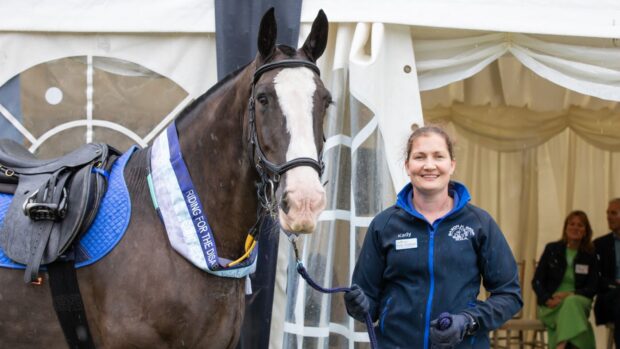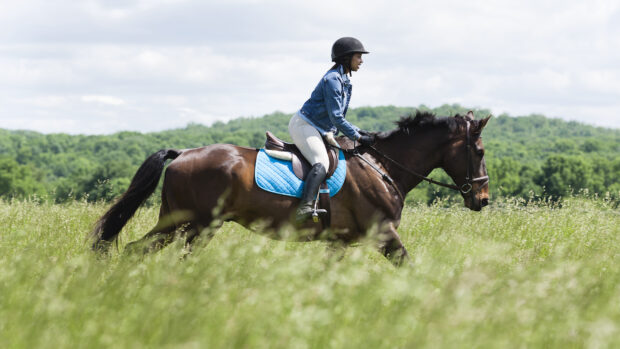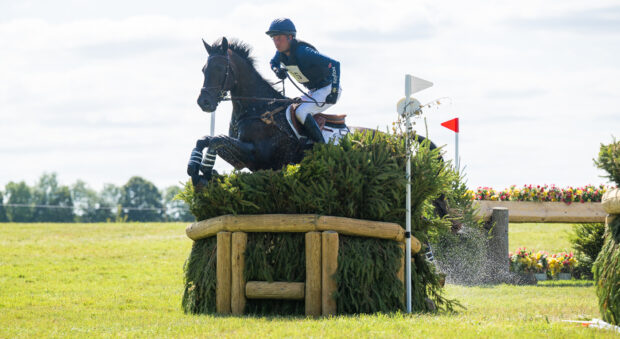We’re back up and running after our Christmas break and were very fortunate to be in the position of having horses waiting to arrive or come back to us after a brief interlude at home over the festive period.
Our whole team had a really good break and so we’re all well rested and ready for the year ahead.
I think I was quite literally the most fresh-faced of all of us having spent nine days at home in Scotland over the holidays – I forgot how much colder it is up there!
Christmas offers me the chance to catch up with my family and also pursue some of my interests outside of horses.
One of these is clay pigeon shooting and although I’m no deadeye by any means, I very much enjoy it. My dad is a really good shot and helps me a lot with my shooting. As with many things, I just don’t get to do it as often as I’d like so it’s great when I do get the chance. It’s a bit of a contrast to my horse-related sports, particularly Eventing.
 I’ve read about lots of jockeys playing golf as an alternative pastime to racing and I think it’s probably a similar contrast. I’m reliably informed that shooting is all about balance, timing and precision but I’m not sure how many of those qualities feature in my repertoire!
I’ve read about lots of jockeys playing golf as an alternative pastime to racing and I think it’s probably a similar contrast. I’m reliably informed that shooting is all about balance, timing and precision but I’m not sure how many of those qualities feature in my repertoire!
Although I do it for fun, my competitive streak is never very far from the surface and I like to have a crack at some of the higher stands and challenge myself a bit. It’s really quite a different lifestyle when I go up north but I do love it. A change is as good as a rest they say.
Presents for all
It’s true to say that we use a fair amount of kit to rehabilitate our horses, and amongst the big stuff like the high-speed and Aquafit water treadmills, we also need a full compliment of electrotherapy equipment to do our job.
I bought us a new Interferential machine (pictured top) in December which arrived just in time for Christmas, although the fridge magnet Scrabble we received for the office was probably the more popular of the two as far as presents go!
We get our machines from EMS Physio Ltd who are long-standing suppliers to us and a super to deal with.
The Interferential machines are made for human use and we don’t adapt them from this, which does mean that we have to take great care of them as they are not particularly horse-proof.

The delivery of the Interferential machine
Interferential therapy is key to our ability to manage pain in our patients, but isn’t really a spectator sport. The effects of most of the types of treatment the machine provides are not visible to the eye and the horse should literally relax and go to sleep throughout if the machine is working as it should.
It is very labour intensive, as each individual treatment (or block as we call them) takes 20mins and one horse may have need three or four different blocks each day. We stand with them for the entire duration of their treatments to ensure both horse and machine stay where they should and so it’s not the most popular job in winter!
So why do we use it? Well, in the first instance, the effects of this type of therapy are far more exciting than the logistics.
Interferential therapy is really clever in that it has the physiological effects of low frequency electrical stimulation, without the associated discomfort within superficial tissues such as the skin.
To achieve this it works on a medium frequency that effectively mimics low frequency currents, thus allowing the user to treat deeper tissues without the pain of low frequency stimulation.
We use it to provide pain relief in backs, necks, hindquarters — basically anywhere you can get the pads to stay — to reduce or remove the need for drug therapy.
Interferential can also be used to innervate muscle and generate activity within the tissues, which is really useful for horses who are not yet ready for a lot of work as you are in effect stimulating specific muscle groups whilst the horse is standing still.
We also use it for those who have pain or atrophy in deep tissues that can’t be externally palpated, such as Illiopsoas, a muscle situated within the pelvic cavity, which is a really important contributor to hind limb flexion and engagement.
Interferential is not a stand-alone treatment for us and would not replace a dynamic work session, but it is very good at supporting muscular development in a horse restricted to controlled exercise.
Looking ahead
January is looking really busy so far, particularly in the number of research projects we have been asked to assist with or facilitate.
Dissertation season is fast approaching for many students here at Hartpury and we are involved in a number of studies, the data collection for which all seems to fall at the end of this month.
There are a variety of projects on the go, all of which will be aimed at scientific publication and so there is a lot to do in terms of recruiting different horses for different studies. To this end we have a bank of student and staff horses who we train up on our treadmills for such purposes throughout the year.
My own horse Charlie is committed to about four different studies so far this month already — I have a feeling he features so much in projects that he will warrant a Nobel Prize for his contribution to developments in equine kinematics by the end of 2015!
Fizz





